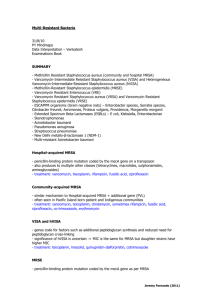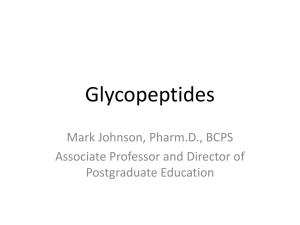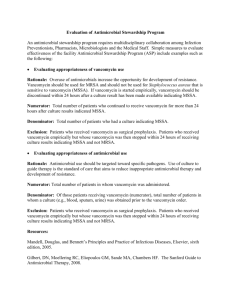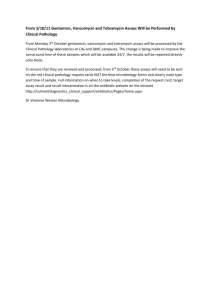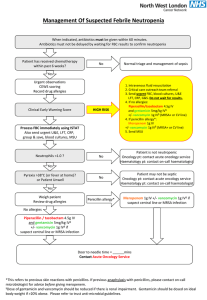Document 13310310
advertisement
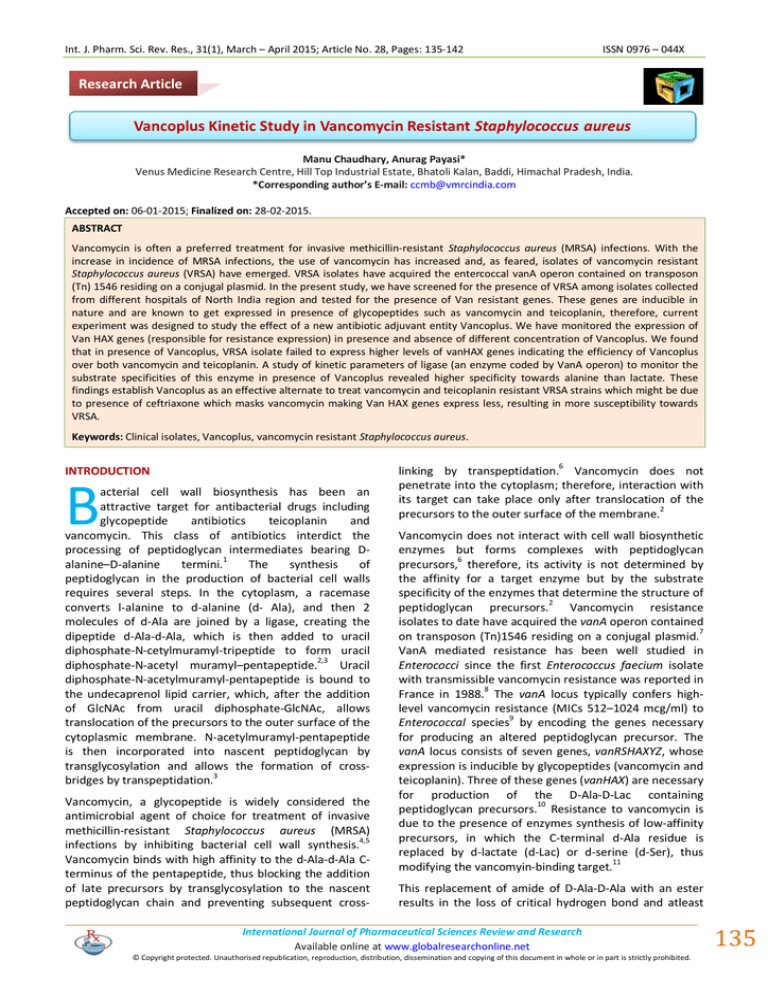
Int. J. Pharm. Sci. Rev. Res., 31(1), March – April 2015; Article No. 28, Pages: 135-142 ISSN 0976 – 044X Research Article Vancoplus Kinetic Study in Vancomycin Resistant Staphylococcus aureus Manu Chaudhary, Anurag Payasi* Venus Medicine Research Centre, Hill Top Industrial Estate, Bhatoli Kalan, Baddi, Himachal Pradesh, India. *Corresponding author’s E-mail: ccmb@vmrcindia.com Accepted on: 06-01-2015; Finalized on: 28-02-2015. ABSTRACT Vancomycin is often a preferred treatment for invasive methicillin-resistant Staphylococcus aureus (MRSA) infections. With the increase in incidence of MRSA infections, the use of vancomycin has increased and, as feared, isolates of vancomycin resistant Staphylococcus aureus (VRSA) have emerged. VRSA isolates have acquired the entercoccal vanA operon contained on transposon (Tn) 1546 residing on a conjugal plasmid. In the present study, we have screened for the presence of VRSA among isolates collected from different hospitals of North India region and tested for the presence of Van resistant genes. These genes are inducible in nature and are known to get expressed in presence of glycopeptides such as vancomycin and teicoplanin, therefore, current experiment was designed to study the effect of a new antibiotic adjuvant entity Vancoplus. We have monitored the expression of Van HAX genes (responsible for resistance expression) in presence and absence of different concentration of Vancoplus. We found that in presence of Vancoplus, VRSA isolate failed to express higher levels of vanHAX genes indicating the efficiency of Vancoplus over both vancomycin and teicoplanin. A study of kinetic parameters of ligase (an enzyme coded by VanA operon) to monitor the substrate specificities of this enzyme in presence of Vancoplus revealed higher specificity towards alanine than lactate. These findings establish Vancoplus as an effective alternate to treat vancomycin and teicoplanin resistant VRSA strains which might be due to presence of ceftriaxone which masks vancomycin making Van HAX genes express less, resulting in more susceptibility towards VRSA. Keywords: Clinical isolates, Vancoplus, vancomycin resistant Staphylococcus aureus. INTRODUCTION B acterial cell wall biosynthesis has been an attractive target for antibacterial drugs including glycopeptide antibiotics teicoplanin and vancomycin. This class of antibiotics interdict the processing of peptidoglycan intermediates bearing Dalanine–D-alanine termini.1 The synthesis of peptidoglycan in the production of bacterial cell walls requires several steps. In the cytoplasm, a racemase converts l-alanine to d-alanine (d- Ala), and then 2 molecules of d-Ala are joined by a ligase, creating the dipeptide d-Ala-d-Ala, which is then added to uracil diphosphate-N-cetylmuramyl-tripeptide to form uracil diphosphate-N-acetyl muramyl–pentapeptide.2,3 Uracil diphosphate-N-acetylmuramyl-pentapeptide is bound to the undecaprenol lipid carrier, which, after the addition of GlcNAc from uracil diphosphate-GlcNAc, allows translocation of the precursors to the outer surface of the cytoplasmic membrane. N-acetylmuramyl-pentapeptide is then incorporated into nascent peptidoglycan by transglycosylation and allows the formation of crossbridges by transpeptidation.3 Vancomycin, a glycopeptide is widely considered the antimicrobial agent of choice for treatment of invasive methicillin-resistant Staphylococcus aureus (MRSA) infections by inhibiting bacterial cell wall synthesis.4,5 Vancomycin binds with high affinity to the d-Ala-d-Ala Cterminus of the pentapeptide, thus blocking the addition of late precursors by transglycosylation to the nascent peptidoglycan chain and preventing subsequent cross- linking by transpeptidation.6 Vancomycin does not penetrate into the cytoplasm; therefore, interaction with its target can take place only after translocation of the precursors to the outer surface of the membrane.2 Vancomycin does not interact with cell wall biosynthetic enzymes but forms complexes with peptidoglycan precursors,6 therefore, its activity is not determined by the affinity for a target enzyme but by the substrate specificity of the enzymes that determine the structure of peptidoglycan precursors.2 Vancomycin resistance isolates to date have acquired the vanA operon contained on transposon (Tn)1546 residing on a conjugal plasmid.7 VanA mediated resistance has been well studied in Enterococci since the first Enterococcus faecium isolate with transmissible vancomycin resistance was reported in 8 France in 1988. The vanA locus typically confers highlevel vancomycin resistance (MICs 512–1024 mcg/ml) to Enterococcal species9 by encoding the genes necessary for producing an altered peptidoglycan precursor. The vanA locus consists of seven genes, vanRSHAXYZ, whose expression is inducible by glycopeptides (vancomycin and teicoplanin). Three of these genes (vanHAX) are necessary for production of the D-Ala-D-Lac containing peptidoglycan precursors.10 Resistance to vancomycin is due to the presence of enzymes synthesis of low-affinity precursors, in which the C-terminal d-Ala residue is replaced by d-lactate (d-Lac) or d-serine (d-Ser), thus 11 modifying the vancomyin-binding target. This replacement of amide of D-Ala-D-Ala with an ester results in the loss of critical hydrogen bond and atleast International Journal of Pharmaceutical Sciences Review and Research Available online at www.globalresearchonline.net © Copyright protected. Unauthorised republication, reproduction, distribution, dissemination and copying of this document in whole or in part is strictly prohibited. 135 © Copyright pro Int. J. Pharm. Sci. Rev. Res., 31(1), March – April 2015; Article No. 28, Pages: 135-142 1000 folds decrease in affinity of the drug to the target site, yielding a net clinical result of drug resistance.12 In all the types of glycopeptide resistances, a key element is the synthesis of an ATP-dependent ligase (Ddl) capable of 13 preferential synthesis of D-Ala-D-X (X-Lactate). VanR and VanS, encoded immediately upstream of vanHAX, comprise a two-component regulatory system responsible for the glycopeptide inducibility of vanHAX expression and vanSR gene clusters. VanS is a membrane localized histidine kinase with an extracellular loop that has been proposed to be involved in sensing vancomycin leading to autophosphorylation of a conserved histidine 14 residue. This phosphoryl group is transferred to an aspartate in the cognate transcriptional activator, VanR similar to other two component systems.15 It has been shown in Enterococci that upon induction with vancomcyin, the VanRS two-component system activates its own promoter and that of vanHAX leading to altered peptidoglycan precursors that confer resistance. VanY is a carboxypeptidase that is not necessary for resistance, but contributes to the resistance level.16 VanZ confers resistance to teicoplanin by an unknown mechanism. With this background, we have also studied the substrate specificities of ligase to confirm its role in vancomycin resistant MRSA. Further we aimed to study the effect of new antibiotic entity Vancoplus on expression levels of VanHAX genes in comparison with vancomycin and teicoplanin. MATERIALS AND METHODS ISSN 0976 – 044X allowed to stand at room temperature for 5 min. To this 3 ml of solution containing 3 M potassium acetate and 5 M glacial acetic acid was added, mixed gently and incubated on ice for 10 min. The tubes were then centrifuged at ° 14000 rpm for 2 min at 4 C and the supernatant were discarded. To the residue 8 ml isopropanol was added and incubated for 2 min. Then the tubes were centrifuged to remove the contaminants accumulated in the supernatant and residual plasmid DNA was washed in 70 % ethanol before dissolving it in minimum volume of TE buffer. PCR for VanA gene cluster (vanR, vanS, vanH, vanA and vanX) was carried out as describes previously.19,20 Details of the primers used for screening of these genes are given in Table 1. Table 1: List of Primers used in the study. Size of PCR product Reference 645 Miele TTGGTTATAAAATTGAAAAATAA TTAGGACCTCCTTTTATC 1155 Whitener vanH 1 vanH 2 ATCGGCATTACTGTTTATGGAT TCCTTTCAAAATCCAAACAGTTT 943 Miele vanA 1 vanA 2 ATGAATAGAATAAAAGTTGCAATAC CCCCTTTAACGCTAATACGAT 1029 Miele vanX 1 vanX 2 ATGGAAATAGGATTTACTTT TTATTTAACGGGGAAATC 609 Whitener Primer Sequence 5' to 3' vanR 1 AGCGATAAAATACTTATTGTGGA vanR 2 CGGATTATCAATGGTGTCGTT vanS 1 vanS 2 Bacterial Isolates Effect of Antibiotics on Growth of Bacteria A total of 165 MRSA isolates were obtained from different clinical samples (blood, urine, pus, throat swabs, wound and ear swabs) from India over a period of 18 months from January 2013 to June 2014. S. aureus was identified by colony morphology, Gram stain, DNase, catalase and coagulase tests and fermentation of mannitol by conventional methods. Effect of different antibiotics on the bacterial growth was studied. For bacterial growth curve studies, the vancomycin resistant strains were grown on MHA plates. The following day, a colony from all the plates was inoculated into respective MHB medium supplemented with 2 mg/ml of respective antibiotics (which ensures the maintenance of resistant gene induction conditions), ° followed by incubation for 16 hours at 37 C under aerobic conditions. The next day, overnight cultures were diluted 1:100 in fresh MHB, again with 2 mg/ml of respective antibiotics to maintain expression of genes. Bacteria were then harvested at mid-log (OD600 of 0.5) and stationary (OD600 of 1.0) growth phases as assessed by spectrophotometer. (Shimadzu UV-1800) Minimal Inhibitory Concentration (MIC) MIC of vancomycin was determined by agar dilution 17 method using CLSI guidelines. Briefly, gradient plates of Mueller-Hinton agar (Hi- media were prepared with vancomycin (0.5-256 µg/l, Sigma- Aldrich). 0.5 McFarland equivalent inoculum prepared using 18-24 h old culture was spotted on to gradient plates. Plates were incubated overnight at 35°C for 24 h before assessing the visible growth. The vancomycin resistant strains confirmed were subjected to the MIC studies with teicoplanin (0.25 – 512 µg/ml) and Vancoplus (0.25 – 512 µg/ml). Plasmid Deoxyribonucleic Acid (DNA) Isolation Plasmid DNA from VRSA strains was isolated according to method described earlier.18 Briefly exponential phase bacterial cells grown in medium supplemented with or without antibiotic were suspended in TE buffer (pH 8) containing 2% glucose. To this 4 ml of solution containing 1% SDS and 0.2 N NaOH was added and the tubes were Effect of Antibiotics on VanA gene cluster gene expression Since vanA gene expression are inducible in nature, the effect of antibiotics on the expression of antibiotic resistance genes was studied. The bacterial growth and steady state expression of vanH, vanA and vanX genes were evaluated under continuous antibiotics (either of vancomycin, teicoplanin and Vancoplus) inducing conditions. The vancomycin resistant strains previously isolated were grown on MHA plates. The following day, a colony from all the plates was inoculated into respective International Journal of Pharmaceutical Sciences Review and Research Available online at www.globalresearchonline.net © Copyright protected. Unauthorised republication, reproduction, distribution, dissemination and copying of this document in whole or in part is strictly prohibited. 136 © Copyright pro Int. J. Pharm. Sci. Rev. Res., 31(1), March – April 2015; Article No. 28, Pages: 135-142 MHB) medium supplemented with 2 mg/ml of respective antibiotics to induce VanA gene cluster genes, followed by incubation for 16 hours at 37°C under aerobic conditions. The next day, bacterial cells were diluted and harvested as above for the extraction of RNA and subsequently to analyze the expression levels by qualitative reverse transcriptase PCR. RNA Isolation, cDNA Transcription PCR Construction and Reverse RNA from bacterial cells (with or without antibiotic treatment) was extracted according to the method described earlier.21 Briefly, after desired incubation period, bacterial cells were pelleted out by centrifugation at 8000 rpm for 5 min. The pellet was resuspended in TE buffer containing 0.2% Triton-X-100 and boiled for 10 min ° at 100 C in water bath. The tubes were then immediately transferred to an ice bath and equal volume of chloroform: methanol (2:1) mixture was added and mixed thoroughly. The tubes were then centrifuged at 12000 rpm at 4 °C for 10 min and aqueous phase was collected. To this equal volume of chloroform was added and the aqueous phase was recollected. To this two volumes of prechilled ethanol was added to precipitate RNA. The precipitated RNA was separated by centrifugation (12000 rpm, 10 min, 4 °C), washed (with 70 % ethanol) and dissolved in minimum volume of water. The RNA concentration was determined from the optical density at 260 nm, and the quality was determined from the A260/A280 ratio. cDNA was prepared by pre-incubating 2 µg RNA with 1µl of oligo-dT followed by incubation of this mixture with 1 µl DTT, 0.5 µldNTP and 0.3 µl Moloney murine leukemia virus reverse transcriptase at 37 °C for 1 hour. The primers and PCR conditions used in the study is given in Table 2. The expression levels were calculated by quantifying the PCR products by ethidium bromide staining on a 0.8% agarose gel. Table 2: List of Primers used for qualitative PCR in the study Primer Sequence 5' to 3' vanH 1 vanH 2 CGGATAGCGTTGCCGATTAT GCTCAATAACCGCTTTGCCT vanA 1 vanA 2 TTATAACCGTTCCCGCAGAC AAACATATCCACACGGGCTAG vanX 1 ATCGCATTGTAGGGACATACG vanX 2 AAGCAATCCGTACCCTTGG Antibiotic Treatment, Purification Enzyme extraction and ISSN 0976 – 044X at mid-exponential phase and were subjected to washing with a solution of 0.85% NaCl and 5% glycerol. All the operations were carried at -4°C unless otherwise stated. Cells were lysed in a minimum volume of lysis buffer (50 mM HEPES buffer pH 7.5 containing 300 mM NaCl, 2 mM EDTA, 1 mM DTT and 1mM PMSF) by passing 3 times through a french press cell operating at 20000 Psi. Upon centrifugation at 10000 rpm for 10 min, the precipitate was again extracted with a minimum amount of lysis buffer and the pooled supernatants were diluted with 50 mM HEPES buffer pH 7.5 to give a solution less than 150 mM in NaCl. The extracted crude protein samples was immediately applied to a Q sapharose column (50 ml) pre-equilibrated with HEPES buffer and eluted with a NaCl gradient of 150 mM to 500mM over a volume of 200 ml. Fractions containing enzyme activity are pooled and concentrated. The concentrate was applied to a Superdex S-200 column (100 ml) pre-equilibrated with HEPES buffer supplemented with 100 mM NaCl. Active fractions were pooled and applied phenyl superose (1.5 X 5.5 cm Pharmacia) column equilibrated with HEPES buffer supplemented with 1.7 M ammonium sulfate. Proteins were eluted with a gradient of 1.7 M to 0 M ammonium sulfate. Ligase Enzyme Assay and Kinetic Studies Enzyme assays and kinetic studies were carried out by monitoring the production of inorganic phosphate using malachite green/ ammonium molybdate solution with detection of green chromophore at 600 nm.22 All ligase assays contained 50 mM HEPES (pH. 8.6), 10 mM MgCl2, 10 MM KCl in a final volume of 1 ml and were incubated at 37 °C for 30 min. Dipeptide ligase assay also contained various concentrations of ATP and D-Ala and enzyme (2-3 mg). Depsipetide ligase assay contained D-Ala, ATP and different concentration of D-Lac and enzyme (2-3 mg). Depsipetide formation rates were calculated by subtracting the rate of reaction measured in presence of D-Ala alone from all the measured rates. The depsipetide ligase incorporates to D-amino or hydroxy acid molecules per catalytic steps and thus two Km values are measurable theoretically. However the Km for N-terminal amino acid (Km1) is very low and more difficulty to measure than the Km (Km2) for the C-terminal amino of hydroxy acid23 and thus only Km2 is measured. The enzyme activity data were fit to a standard MM model using Graphpad Prism 5.0 software to allow for the calculation of the enzymatic parameter V max and Km in the presence of different concentration of substrates. RESULTS The bacteria were grown in MHB medium containing antibiotic or lacking antibiotic (control medium). For the preparation of the medium containing antibiotic, subinhibitory concentrations of either vancomycin, teicoplanin and Vancoplus (half MIC/ml concentration) were added to the growth medium. Cells were harvested The MIC for 138 out of 165 isolates (83.63 %) for vancomycin was ≤2 mg/l indicating that all these MRSA were sensitive to vancomycin. Twenty one (12.27%) isolates showed MIC range between 4-8 mg/l, indicating vancomycin intermediate resistance nature of the isolates. However, for the remaining 6 isolates (3.6 %), International Journal of Pharmaceutical Sciences Review and Research Available online at www.globalresearchonline.net © Copyright protected. Unauthorised republication, reproduction, distribution, dissemination and copying of this document in whole or in part is strictly prohibited. 137 © Copyright pro Int. J. Pharm. Sci. Rev. Res., 31(1), March – April 2015; Article No. 28, Pages: 135-142 the MIC was in the range of 16-128 mg/l indicating that these isolates are vancomycin resistant (VRSA). All vancomycin intermediate and resistant strains were grown on BHI vancomycin screen agar confirming the resistance towards vancomycin. The 6 vancomycin resistant isolates also showed resistance towards teicoplanin with MIC ranges from (MIC 32-64 mg/l), where as the isolates were sensitive to the Vancoplus (MIC ranges from 0.25 – 4 mg/l). PCR-based Detection of Vancomycin-Resistance Genes PCR carried out for the 6 VRSA isolates with plasmid DNA as a templet and with appropriate primers for the detection of vanA, vanH and vanX genes revealed amplicons of approximately 1032 bp, 969 bp and 603 bp sizes which corresponds to vanA, vanH and vanx genes respectively. The results confirmed the possession of Van genes by the plasmid of VRSA. Among the 6 VRSA isolates (VanHAX positive), one VanHAX positive isolate named as VRVR1 with MIC values (vancomycin: 32 µg/ml, teicoplanin: 64 µg/ml and Vancoplus: 4 µg/ml) was selected for further studies. ISSN 0976 – 044X duration of the lag phase by about 12 hrs and at higher sub inhibitory concentration (>3 mg/l), Vancoplus completely inhibited the growth. Effect of Antibiotics on Expression of VanH, VanX and VanA Along with growth curve studies, the expression levels of VanH, VanX and VanA genes in presence of antibiotics was also studied simultaneously. As shown in (Figure 2) the exposure of bacterium to half MIC concentration of vancomycin (16 mg/l) and teicoplanin (32 mg/l) induced the expression of VanH, VanX and VanA genes. Where as treatment with higher sub inhibitory concentration of antibiotics (vancomycin 24 mg/l and teicoplanin 48 mg/l) resulted in further increased expression of these genes. Contrary to this, the expression of these vancomycin resistant genes was very low when the bacterium was exposed to the half MIC concentration (2 mg/l) of Vancoplus. At higher sub inhibitory concentration (>3 mg/l) the expression levels of these genes could not be studied as the growth of bacterium was completely inhibited (Figure 3). Growth Curve Studies Ligase Purification and Kinetic Studies Comparison of growth curves in absence and in presence of different concentrations of vancomycin, teicoplanin and Vancoplus is depicted in (Figure 1). At half MIC concentrations of vancomycin and teicoplanin (MIC 16 mg/l and 32 mg/l respectively), the growth rate of the VRVR1 were similar with that of growth rate in absence of antibiotics. At higher sub-inhibitory concentrations (vancomycin 24 mg/l and teicoplanin 48 mg/l), even though there was an observed growth of the VRVR1 strain, both vancomycin and teicoplanin increased the lag growth phase of the bacterium to over 10 hrs and 11.5 hrs respectively. On the other hand, presence of Vancoplus (half MIC concentration; 2 mg/l), increased the Ligase enzyme extracted from control medium (absence of antibiotic) and the medium treated with antibiotics were subjected to the three step purification process. Three steps used for the purification of the ligase include Q sapharose, Superdex S-200 followed by phenyl superose column. The ligase enzyme from the control medium was purified up to 10.66 folds with a final yield of 0.99 percent. Purification steps, total activity, specific activity, purification factor and percentage of yield are summarized in Table 3. The enzymes from antibiotic treated medium were also purified similarly (data not shown) and used further for enzyme kinetic studies. Figure 1: Growth curve studies of VRVR1 at half MIC (A) and higher sub inhibitory concentrations of different antibiotics (B). International Journal of Pharmaceutical Sciences Review and Research Available online at www.globalresearchonline.net © Copyright protected. Unauthorised republication, reproduction, distribution, dissemination and copying of this document in whole or in part is strictly prohibited. 138 © Copyright pro Int. J. Pharm. Sci. Rev. Res., 31(1), March – April 2015; Article No. 28, Pages: 135-142 Figure 2: Relative fold expression levels of vancomycin resistance genes at half MIC concentrations of different antibiotics. ISSN 0976 – 044X Figure 3: Relative fold expression levels of vancomycin resistance genes at higher sub inhibitory concentrations of different antibiotics. Table 3: Purification summary of ligase enzyme extracted from VRSA isolates grown in control medium (absence of antibiotics) Fraction Volume (ml) Total Protein (mg) Activity (U/mg) Total activity (U * ml) Sp. activity (U/mg) Fold Purification % yield Crude 50 136 0.866 43.300 0.0063 1 100 Q sapharose 29 73.66 0.676 19.604 0.0091 1.44 45.27 Superdex S-200 12 25.08 0.366 4.392 0.0146 2.31 3.21 phenyl superose 1.8 4.12 0.277 0.443 0.0672 10.66 0.998 Table 4: Kinetic parameters of ligases in presence of different antibitics. Drug Substrate D-Ala Absence of antibiotics a b ATP 0.973 57.110 a 265.600 d Vancomycin ATP 0.807 D-Lac e 1.302 D-Ala a 12.940 f Vancoplus ATP 0.866 D-Lac g 23.680 D-Ala a 222.500 h Teicoplanin 3.569 c D-Lac D-Ala Km2 (mM) ATP D-Lac 0.633 i 2.357 a - ATP (2 mM) – D-Ala (5mM) c – D-Ala (5 mM) and ATP (2 mM) d – D-Ala (250 mM) e - D-Ala (250 mM) and ATP (2 mM) f – D-Ala (25 mM) g - D-Ala (25 mM) and ATP (2 mM) h - D-Ala (225 mM) b i - D-Ala (250 mM) and ATP (2 mM) The results of the ligase enzyme kinetic studies carried out with enzyme from control medium showed high specificity towards D-ala (Km - 3.57) over D-lac (Km – 57.11). However, in presence of vancomycin, the specificity towards D-Ala had reduced drastically with high Km values (Km – 265.6) and specificity towards D-Lac (Km – 1.3026) had increased significantly. Similar results were observed in presence of teicoplanin with high specificity towards D-Lac (Km – 2.357) over D-Ala (Km – 222.5). On the other hand, when the bacterium was grown in presence of Vancoplus which contains ceftriaxone along with vancomycin, substrate specificity remained normal; i.e. high specificity towards D-Ala (Km – 12.94) than D-Lac (Km –23.68) (Table 4). DISCUSSION Infections caused by multi drug-resistant S. aureus have been associated with high morbidity and mortality rates. In Indian hospitals, MRSA is one of the common causes of hospital-acquired infections and 30 to 80 per cent methicillin resistance in S. aureus based on antibiotic sensitivity tests has been reported from different hospitals.24 Along with resistance to methicillin, development of resistance to vancomycin is an alarming problem. Vancomycin is the main antimicrobial agent available to treat serious infections with MRSA. Unfortunately, decrease in vancomycin susceptibility of S. aureus and isolation of vancomycin intermediate and resistant S. aureus have recently been reported from many countries.25 In present study MIC studies revealed that among the tested isolates 21 MRSA are having International Journal of Pharmaceutical Sciences Review and Research Available online at www.globalresearchonline.net © Copyright protected. Unauthorised republication, reproduction, distribution, dissemination and copying of this document in whole or in part is strictly prohibited. 139 © Copyright pro Int. J. Pharm. Sci. Rev. Res., 31(1), March – April 2015; Article No. 28, Pages: 135-142 intermediate vancomycin resistance and 6 MRSA isolates resistant to vancomycin. These vancomycin resistant isolates were further confirmed by growth on vancomycin agar plates containing vancomycin at a concentration of 2 mg/l. These results are threatening indications for the increased trend in the vancomycin resistance. Though first case of VRSA was reported in 2002 in USA (CDCP 2002), few other countries have earlier reported the reduced susceptibility of S. aureus against glycopeptides.26-34 Recently Pallazo29 have also reported some vancomycin resistant strains in Brazil. Assadullah34 have reported some strains of vancomycin intermediate S. aureus (VISA) from India. Song35 have also been reported the emergence of heterogeneous vancomycin resistant S. aureus strains from India and its neighboring countries. Many other reports from north India also recorded the emergence of low level and intermediate vancomycin resistance.36-40 The resistance to vancomycin results by the horizontal acquisition of the vanA gene cluster.41 The PCR based detection of vancomycin resistance genes revealed presence of VanA cluster genes (VanH, VanX and VanA) in all the isolates and these genes might be playing a significant role in development of resistance towards vancomycin. These genes help the bacteria to develop resistance by forcing the production of an alternative peptidoglycan precursor to replace the wild type precursors. Growth curve studies revealed the adaptive nature of the VRVR1 in presence of half MIC concentration of vancomycin and teicoplanin, witnessed by similar growth curve as that of the growth rate in absence of antibiotics. But the same antibiotics at higher sub-inhibitory concentrations increased the lag phase delaying the growth of the bacterium. On the other hand, a surprising fact observed was that growth of the VRVR1 was delayed with prolonged lag phase in presence of Vancoplus and that too at lower half MIC concentrations, advocates the sensitivity of the bacterium towards Vancoplus. The growth curve patterns in presence or absence of antibiotics lead us to check whether these patterns have any correlation with the expression levels of VanA gene cluster genes. Results of these studies were as predicted. The increased expressions of VanH, VanA and VanX genes in presence of half MIC concentration of vancomycin and teicoplanin can be attributed to the response of the bacterium to the antibiotic consisting environment, where expression of these genes help the bacteria to growth normally. However, treatment of bacterium with higher sub inhibitory concentrations of antibiotics (below inhibitory concentration) resulted in further increased expression of these genes along with increased lag phase. This advocates the direct influence of VanA gene cluster gene expression on bacterial growth and resistance. ISSN 0976 – 044X 42 Qureshi also observed the increased expression of VanA genes in presence of vancomycin. Contradictorily, the presence of Vancoplus at half MIC concentrations did not induce the VanH, VanX and VanA gene expression which forced to believe that this failure of bacterium to express these genes didn’t enable it to grow normally in presence of Vancoplus which is witnessed by increased lag phase. Kinetic studies of ligase in absence of antibiotics showed high specificity towards D-Ala and very low specificity towards D-Lac as substrates. However in presence of vancomycin the specificity of ligase towards D-Ala decreased and at the same time specificity towards D-Lac 13 increased considerably. Marshal and Write also observed similar results reporting increased and decreased specificities of ligase towards D-Lac and D-Ala respectively in presence of vancomycin. The altered or swaped specificity of ligase towards D-Ala and D-Lac results in the efficient synthesis of D-Ala-D-Lac in place of D-Ala-DAla and thus, vancomycin can not bind to this altered peptide resulting in Vancomycin resistance. This alteration is attributed to the induced resistance of bacterium in presence of vancomycin. Similar results were observed in presence of teicoplanin with high specificity towards D-Lac than D-Ala. The induced resistance observed towards teicoplanin in our studies is in accordance with the previous reports (Hutchings), which reports the resistance induction in presence of lipidated glycopeptide teicoplanin. On the other hand, when the bacterium was grown in presence of Vancoplus, substrate specificity remained normal as in the case of specificity in absence of antibiotics. This behaviour of ligase with respect to the substrate specificity even in presence of antibiotics is interesting, because Vancoplus also contains vancomycin. However the presence of ceftriaxone along with vancomycin might have masked vancomycin making it unavailable for the bacterial regulatory system which develops resistance only if it senses the vancomycin (glycopeptide). This possibility might open a new area which still needs to be explored and could be of great clinical significance to use against these deadly pathogens. CONCLUSION In conclusion, present study explored the emergence of vancomycin and teicoplanin resistance in MRSA strains in India. The gradual increase in vancomycin resistance sends an alarming signal to look for the new alternatives to treat pathogens. In present study, a direct correlation was established between the presence of antibioticexpression of the VanA cluster genes and growth of the bacterium. The effect of expression of these genes was further confirmed by ligase kinetic studies carried out with purified ligase (VanA gene product). One of the major finding of this study is the efficiency of the antibiotic adjuvant entity Vancoplus to negotiate the well established resistance mechanism of VRVR1 providing a positive hope in treatment options for the clinicians. International Journal of Pharmaceutical Sciences Review and Research Available online at www.globalresearchonline.net © Copyright protected. Unauthorised republication, reproduction, distribution, dissemination and copying of this document in whole or in part is strictly prohibited. 140 © Copyright pro Int. J. Pharm. Sci. Rev. Res., 31(1), March – April 2015; Article No. 28, Pages: 135-142 Acknowledgement: Authors also thankful to sponsor, Venus Pharma GmbH, AM Bahnh of 1-3, D-59368, Werne, Germany, for providing financial assistance to carry out this study. Source of Support Venus Pharma GmbH, AM Bahnhof 1-3, D-59368, Werne, Germany. REFERENCES 1. Kuzin AP, Sun T, Jorczak-Baillass J, Healy VL, Walsh CT, Knox JR, Enzymes of vancomycin resistance: the structure of dalanine–d-lactate ligase of naturally resistant Leuconostoc mesenteroides. Structure, 8, 2000, 463-470. 2. Courvalin P, Vancomycin resistance in gram-positive cocci. Clin. Infect. Dis., 1, 2006, 42 Suppl 1, S25-34. 3. Reynolds PE, Structure, biochemistry and mechanism of action of glycopeptide antibiotics. Eur. J. Clin. Microbiol. Infect. Dis., 8, 1989, 943-950. 4. Liu C, Bayer A, Cosgrove SE, Daum RS, Fridkin SK, Gorwitz RJ, Kaplan SL, Karchmer AW, Levine DP, Murray BE. Clinical practice guidelines by the infectious diseases society of America for the treatment of methicillin-resistant Staphylococcus aureus infections in adults and children: executive summary. Clin. Infect. Dis., 52, 2011, 285-292. 5. 6. Rivera AM, Boucher HW, Current concepts in antimicrobial therapy against select Gram-positive organisms: methicillin-resistant Staphylococcus aureus, penicillinresistant Pneumococci and vancomycin-resistant Enterococci,” Mayo Clinic Proceedings, Quadrant HealthCom Inc., Parsippany, NJ, Vol. 86, 2011, 1230-1242. Lexi-Comp, Lexi-Comp, Inc. http://online.lexi.com/lco/action/home, Dec. 21, 2011. 7. Chang S, Sievert DM, Hageman JC, Boulton ML, Tenover FC, Infection with vancomycin-resistant Staphylococcus aureus containing the vanA resistance gene. N. Engl. J. Med., 348, 2003, 1342-1347. 8. Leclercq R, Derlot E, Duval J, Courvalin P, Plasmid-mediated resistance to vancomycin and teicoplanin in Enterococcus faecium. N. Engl. J. Med., 319, 1988, 157–161. 9. Brisson-Noel A, Dutka-Malen S, Molinas C, Leclercq R, Courvalin P, Cloning and heterospecific expression of the resistance determinant vanA encoding high-level resistance to glycopeptides in Enterococcus faecium BM4147. Antimicrob. Agents Chemother., 34, 1990, 924–927. 10. Arthur M, Depardieu F, Gerbaud G, Galimand M, Leclercq R. The VanS sensor negatively controls VanR mediated transcriptional activation of glycopeptide resistance genes of Tn1546 and related elements in the absence of induction. J. Bacteriol., 179, 1997, 97-106. 11. Arthur M, Reynolds PE, Courvalin P, Glycopeptide resistance in enterococci. Trends Microbiol., 4, 2006, 401407. ISSN 0976 – 044X 12. Bugg TDH, Write GD, Dutka-Malen S, Artur M, Courvalin P and Walsh CT, Molecular basis for vancomycin resistance in Enterococcuc faecium BM 4147: bio-synthesis of depsipeptide peptidoglycan precursor by vancomycin resistance proteins vanH and vanA. Biochem., 30, 1991, 10408-10415. 13. Marshal CG and Write GD, The glycopeptide antibiotic producer Streptomyces toyocaensis NRRL 15009 has both D-alanyl-D-alanine and D-lanyl-D-lactate ligases. Fems. Microbiol. Let., 157, 1997, 295-299. 14. Arthur M, Quintiliani R Jr., Regulation of VanA and VanBtype glycopeptide resistance in enterococci. Antimicrob. Agents Chemother., 45, 2001, 375-381. 15. Stock AM, Robinson VL, Goudreau PN, Two-component signal transduction. Annu. Rev. Biochem., 69, 2000, 183215. 16. Depardieu F, Courvalin P, Msadek T, A six amino acid deletion, partially overlapping the VanSB G2 ATP-binding motif, leads to constitutive glycopeptide resistance in VanB-type Enterococcus faecium. Mol. Microbiol., 50, 2003, 1069-1083. 17. Clinical and Laboratory Standard institute, Methods for dilution antimicrobial susceptibility tests for bacteria that grow aerobically; approved standard-English edition. CLSI document M100-S23. CLSI, Wayne, PA 19087, USA, 2013. 18. Chaudhary M, Payasi A. Inhibition of in vitro mecA gene transfer among Indian clinical isolates of Staphylococus aureus. The J. Appl. Biochem., 106, 2013, 133-139. 19. Whitener CJ, Park SY, Browne FA, Parent LJ, Julian K, Bozdogan B. Vancomycin-resistant Staphylococcus aureus in the absence of vancomycin exposure. Clin. Infect. Dis., 38, 2004, 1049-1055. 20. Miele A, Bandera M, Goldstein BP, Use of primers selective for vancomycin resistance gene to determine van genotype in enterococci and to study gene organization in vanA isolates. Antimicrob. Agents Chemother., 139, 995, 1772– 1778. 21. Sung S, Khan SA, Nawaz MS, Khan AA, A simple and efficient Triton X-100 boiling and chloroform extraction method of RNA isolation from Gram-positive and Gramnegative bacteria. FEMS Microbiol. Lett., 229, 2003, 97101. 22. Lanzetta PA, Alvarez LJ, Reinach PS and Candia OA, An improved assay for nanomole amounts of inorganic phosphate. Anal. Biochem. 100, 1979, 95-9. 23. Write GD and Walsh CT, D-Alanyl-D-alanine ligases and the molecular mechanism of vancomycin resistance. Chem. Res. 25, 1992, 468-473. 24. Anupurba S, Sen MR, Nath G, Sharma BM, Gulati AK, Mohapatra TM, Prevalence of methicillin resistant Staphylococcus aureus in a tertiary referral hospital in eastern Uttar Pradesh. Indian J. Med. Microbiol., 21, 2003, 49-51. 25. Benjamin PH, John KD, Paul DR. J, Timothy PS, Grayson ML, Reduced vancomycin susceptibility in Staphylococcus aureus, including vancomycin-intermediate and heterogeneous vancomycin-intermediate strains: International Journal of Pharmaceutical Sciences Review and Research Available online at www.globalresearchonline.net © Copyright protected. Unauthorised republication, reproduction, distribution, dissemination and copying of this document in whole or in part is strictly prohibited. 141 © Copyright pro Int. J. Pharm. Sci. Rev. Res., 31(1), March – April 2015; Article No. 28, Pages: 135-142 resistance mechanisms, laboratory detection, and clinical implications. Clin. Microbiol. Rev., 23, 2010, 99-139. 26. Tenover FC, Biddle JW, Lancaster MV, Increasing resistance to vancomycin and other glycopeptides in Staphylococcus aureus. Emerg. Inf. Dis., 7, 2001, 327-332. 27. Hiramatsu K, Hanaki H, Ino T, Yabuta K, Oguri T, Tenover FC, Methicillin resistant Staphylococcus aureus clinical strain with reduced vancomycin susceptibility. J. Antimicrob. Chemother., 40, 1997, 135-136. 28. Centers for Disease Control and Prevention Staphylococcus aureus with reduced susceptibility to vancomycin United States, 1997. Morb Mortal Wkly Rep MMWR. 46, 1997, 765-766. 29. Palazzo ICV, Araujo MLC, Darini ALC, First Report of vancomycin-resistant Staphylococci isolated from healthy carriers in Brazil. J. Clin. Microbiol., 43, 2005, 179185. 30. Bataineh AB, Resistance of Staphylococcus aureus to Vancomycin in Zarqa, Jordan. Pak. J. Med. Sci., 22, 2006, 144-148. 31. Ploy MC, Grelaud C, Martin C, de Lumley L, Denis F, First clinical isolate of vancomycin-intermediate Staphylococcus aureus in a French hospital. Lancet., 351, 1998, 1212. 32. Howe RA, Bowker KE, Walsh TR, Feest TG, MacGowan AP, Vancomycin-resistant Staphylococcus aureus. Lancet, 351, 1998, 602. 33. Bierbaum G, Fuchs K, Lenz W, Szekat C, Sahl HG, Presence of Staphylococcus aureus with reduced susceptibility to vancomycin in Germany. Eur. J. Clin. Microbiol. Infect. Dis., 18, 1999, 691–696. 34. Assadullah S, Kakru DK, Thoker MA, Bhat FA, Hussain N, Shah A, Emergence of low level vancomycin resistance in MRSA. Indian J. Med. Microbiol., 21, 2003, 196-198. 35. Song JH, Hiramatsu K, Suh JY, Ko KS, Ito T, Kapi M, Kiem S, Kim YS, Oh WS, Peck KR, Lee NY, Asian network for surveillance of resistant pathogens study group emergence ISSN 0976 – 044X in Asian countries of Staphylococcus aureus with reduced susceptibility to vancomycin. Antimicrob. Agents Chemother., 48, 2004, 4926–4928. 36. Tiwari HK, Sen MR, Emergence of vancomycin resistant Staphylococcus aureus (VRSA) from a tertiary care hospital from northern part of India. BMC Infect. Dis., 6, 2006, 56161. 37. Menezes GA, Harish BN, Sujatha S, Vinothini K, Parija SC, Emergence of vancomycin-intermediate Staphylococcus species in southern India. J. Med. Microbiol., 57, 2008, 911912. 38. Bhateja P, Mathur T, Pandya M, Fatma T, Rattan A, Detection of vancomycin resistance Staphylococcus.aureus: a comparative study of three different phenotyic screening methods. Indian J. Med. Microbiol., 23, 2005, 52-55. 39. Bijiyani B, Purva M, Erroneous reporting vancomycine susceptibility for Staphylococcus spp. Vitek software version 2.01. Jpn. J. Infect. Dis., 62, 2009, 298-299. 40. Veer P, Chande C, Chavan S, Wabale V, Chopdekar K, Bade J, Increasing levels of minimum inhibitory concentration vancomycin in methicillin resistant Staphylococcus aureus alarming bell for vancomycin abusers. Indian J. Med. Microbiol., 28, 2010, 413-414. 41. Handwerger S, Pucci MJ, Volk KJ, Liu J, Lee MS, The cytoplasmic peptidoglycan precursor of vancomycinresistant Enterococcus faecalis terminates in lactate. J. Bacteriol., 174, 1992, 5982-5984. 42. Qureshi NK, Yin S, Boyle-Vavra S, The Role of the Staphylococcal VraTSR Regulatory System on Vancomycin Resistance and vanA Operon Expression in Vancomycin-Resistant Staphylococcus aureus. PLoS ONE, 9, 2014, e85873. 43. Hutchings MI, Hong HJ, Buttner MJ, The vancomycin resistance VanRS two-component signal transduction system of Streptomyces coelicolor. Mol. Microbiol., 59, 2006, 923-935. Conflict of Interest: None. International Journal of Pharmaceutical Sciences Review and Research Available online at www.globalresearchonline.net © Copyright protected. Unauthorised republication, reproduction, distribution, dissemination and copying of this document in whole or in part is strictly prohibited. 142 © Copyright pro
